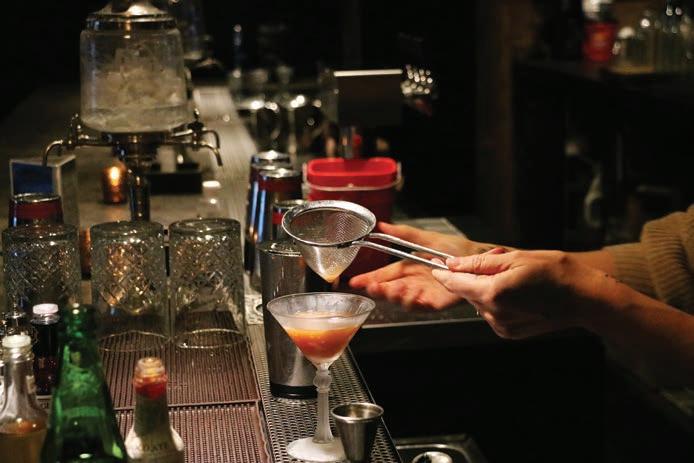
8 minute read
OPTIONS
as well as B vitamins and an acidic composition that some say can help your gut health.
For many, this drink has become a replacement for beer and other alcoholic beverages, partly due to its prevalence in drinking establishments.
“We have some breweries that go through three of these (kegs) in a week,” Gaudreault said.
People who choose not to drink should have options besides a soda, Gaudreault said.
“You want something that is a little more sophisticated,” he said.
Trubucha is located at 10047 Park Meadows Drive Unit A in Lone Tree.
Make it at home yourself
For those looking to have an NA drink at home, e Spice and Tea
Church art show e Ken Caryl Art Guild will exhibit artworks by members from May 5 to June 14 at St. Andrew United Methodist Church, 9203 S. University Blvd., Highlands Ranch. Open 8 a.m. to 5 p.m. weekdays. Opening reception May 7 from 10 a.m. to noon.
Arapahoe Community College
Wine, Art and Design event at Arapahoe Community College on May 18 from 6:30 to 9 p.m. at the ACC Art and Design Center, 2400 W. Alamo Ave., Littleton. Information at: arapahoe.edu/foundationevents. Funds will go to ACC’s Art and Design programs and to ACC Foundation general scholarships.
Plant sale
Plant sale will be at Denver Botanic Gardens, 909 York St. on May 12 and 13, 8 a.m. to 4 p.m. More info e sugar and salt wall, which contains countless canisters of avored granules, is a good place to get ingredients to sweeten your mocktails or rim the glasses, according to Houser. e store has many types of teas, some of which can make for a good mocktail base. soon. See botanicgardens.org.
Exchange in Idaho Springs has almost everything you need to get started on your very own mocktail creation.
Logan Houser, manager at e Spice and Tea Exchange in Idaho Springs, explained that the shop has all sorts of ingredients to make cocktails or mocktails at home.
“It all just depends on what you’re trying to achieve,” he said.
“We have like four or ve teas you can use for mocktails,” Houser said.
He said the fruity teas do really well for those drinks, but you can try out lots of combinations.
“Really anything you buy here is multipurpose,” Houser said.
City Park Jazz City Park Jazz announces the lineup for summer: starting with Sarah Mount and the Rushmores on June 4. Only 3.2 beer allowed in the park (no glass containers). See cityparkjazz.org for schedule.
Aspen Grove art
Arapahoe Community College
Art and Design students will exhibit work at Aspen Grove through May 7, including some mural designs throughout the center. e storefront between See’s Candy and Tattered Cover will hold work, as will space next to the Apple store. 11 a.m. to 7 p.m. ursday-Saturday and 11 a.m. to 5 p.m. Sunday.
Arts workshop
Heritage Fine Arts Guild announces a workshop on May 19 and 20 (9 a.m. to 3 p.m.) with Paul Jackson: “Dramatic Light and Luminosity in Watercolor.” Information: Krista Falkenstine, krista.falken@gmail. com, 720-440-3336 or Jennifer Bird, heritageartworkshops@gmail.com, 303-520-7131. Costs aren’t listed in the information we received. Held at First Presbyterian Church, 1609 W. Littleton Blvd., Littleton.

Littleton Symphony
Littleton Symphony: 7:30 p.m. May 19 at Littleton United Methodist Church, 5893 S. Datura St., Littleton. 303-933-6824, littletonsymphony. org, or at door. Soloist: David Byrd Morrow. Strauss: Horn Concerto.
Colorado Gallery of the Arts e shop also o ers cocktail kits with sugars, teas and syrups to make drinks, which Houser said are popular for people to use for NA drinks. e Spice and Tea Exchange is located at 1634 Miner St. in Idaho Springs.
Colorado Gallery of the Arts at Arapahoe Community College, 5900 S. Santa Fe Drive, hosts “Artist Invitational” through May 5. Open 9-5 Monday to Friday, ursday until 7 p.m.
“You can change them out for club soda,” he said of champagne or other alcohol recommended in the recipes.
If you or someone you know is struggling with addiction, call the alcohol addiction hotline at 331-200-1664, or visit alcohol.org.
Gutierrez’s days, which often start at 4:30 a.m., are crammed with classes, tutoring, workouts at the gym, studying, and time advancing through Alcoholics Anonymous and Narcotics Anonymous followed by religious devotionals and a FaceTime catch-up with her kids.
A $2,000-per-semester scholarship through Finish What You Started helps her cover the cost of school supplies, food and clothes as well as a ord a computer. As Gutierrez moves closer to the day she can cross a stage in a cap and gown, she has become a much more condent version of herself, someone who leans on the resources at her school and knows how to ask for help — things she shied away from in the past.
While mapping out her plan through the graduation timeline she received upon returning to classes, she aims to specialize in research physics, focusing on particle physics and quantum mechanics. Gutierrez will stay the course at Otero College for the next year, building a stronger foundation while continuing her recovery at Fort Lyon in Las Animas before potentially relocating to Pueblo to begin studying physics at Colorado State University Pueblo.
“I know that I’m able to accomplish my goals,” Gutierrez said. “I know that I have support systems, resources and the ability to accomplish my goals.”
Helping students like Gutierrez earn their remaining credits adds up to a communitywide transformation for Colorado’s southeastern pocket, where economic prosperity has lagged other parts of the state, Wheeler said. e program also stands to reshape the state more broadly, equipping it with a more skilled workforce, said Joe Garcia, chancellor of the Colorado Community College System.
“We want to have a homegrown, educated workforce because that’s going to boost the economy in this area, and it’s going to overall build a stronger community with greater resources,” she said.
“It’s not about just helping the student,” Garcia said. “It’s about helping Colorado’s economy. We have too many jobs that are going un lled because we don’t have trained people to ll them. If we can train them, we can get them in the workforce. Our employers are better o , the economy is better o and certainly our students are better o .” at program, called Return to Earn, launched in 2016 as Richie Ince, the college’s downtown studio director, started calling students who were suddenly no longer enrolled to see why they had stopped.
Garcia points to a program at Pueblo Community College that predates the pandemic and in many ways in uenced the development of Finish What You Started, with e ective nancial and academic support.
He heard stories of students overtaken by life circumstances — pregnancies and cancer diagnoses, divorces and the death of a loved one, or rather “life happens moments,” as Ince calls them.
Many of those students were only a few classes away from graduating, and as Ince chatted with them over the phone, he repeatedly heard that students had been thinking about coming back but hadn’t yet taken the rst step.
Pueblo Community College has succeeded in pulling students back into the classroom by helping them sort out funding for school, with Ince guiding students through the nancial aid process, helping them submit their FAFSA and following up to get any additional information needed.
Since Return to Earn’s inception, 450 students have found their way back to Pueblo Community College to nish their schooling, with as many as 120 taking advantage of the program each semester.
Students have walked away credentialed in a variety of elds, Ince said, including law enforcement, nursing, teaching, cosmetology, welding, computer information systems and others. e change tied to personal nance requirements occurred in April 2022 due to a nal fed - eral rule that spells out eligibility. Students receiving funds through the program must have su ered a nancial setback during the pandemic, whether they were laid o or furloughed, experienced a dip in earnings, saw job o ers rescinded or struggled to nd work because of the economic downturn, according to a statement provided by a CDHE spokesperson. Recipients of the federal funds that support the program must “demonstrate negative economic impacts caused by the public health emergency, including economic harms to workers, households, small businesses, impacted industries and the public sector,” according to the statement.
When the program started, students who completed their rst semester with a C or better in all their classes received a $750 scholarship. Now the scholarship is $2,000 — doled out at the end of the semester — with an additional $500 awarded at the end of each additional semester.
In the past seven years, more than 90% of students have passed with grades of C or better in their rst semester back, Ince said.
Pueblo Community College still operates its Return to Earn program and received an infusion of new funding through the Finish What You Started program. While Finish What You Started is funded by federal COVID-19 relief funds facilitated by the Colorado Opportunity Scholarship Initiative, Return to Earn is funded by both the Pueblo Community College Foundation and matching funds from the Colorado Opportunity Scholarship Initiative.
To qualify for Return to Earn, students have to have been out of school for at least two consecutive semesters, not yet earned a degree and fall under a designated income level on their FAFSA, the federal student aid application.
To qualify for Finish What You Started, students have to either qualify for a Pell Grant, live in a certain geographic area or fall within the 300% poverty line. e program used to only require students to have been out of school for at least two consecutive semesters and have no degree, but criteria changed last year with new personal nance restrictions.
Now, students who earn too much to qualify for nancial aid but who don’t make enough money to put themselves through school aren’t eligible for Finish What You Started funding.
Some of those students are already back in classes, and COSI — a division of CDHE that facilitates the Finish What You Started program — is communicating to schools that the state will still move forward with granting funds to those students. Even if a student who previously quali ed for help through Finish What You Started no longer quali es, they will still get the funding they were initially promised, said Cynthia Armendariz, managing director of COSI.


“We continue to explore ways that can be demonstrated and are looking at all ways to expand who is eligible” while following federal parameters, the statement noted, adding that CDHE has reached out to colleges and universities across the state to learn more about how the program has been implemented and to ask for “technical clari cations and additional documentation” so that the state can make sure to ful ll necessary reporting requirements for the federal recovery funds.
Armendariz said that her division learned about how changes were a ecting schools earlier this spring, close to a year after the nal federal rule was released. She said the lag was due to challenges with trying to understand what the nal federal rule meant and how it would impact programs and schools.
“We are honoring our commitment to students and want to ensure there is no disruption in their path to completion,” Armendariz said.
Ince has seen support from the programs lead many students to a much more stable nancial footing. A survey of former students that Ince conducted in 2019 comparing their income before and after graduating revealed that, of 63 respondents, 57 were employed, and each student’s annual income jumped by an average of 151%.
“Financially, they’re much better o than they were before they came back,” Ince said. “ ey’re providing for their families more.” is story is from e Colorado Sun, a journalist-owned news outlet based in Denver and covering the state. For more, and to support e Colorado Sun, visit coloradosun. com. e Colorado Sun is a partner in the Colorado News Conservancy, owner of Colorado Community Media.


























